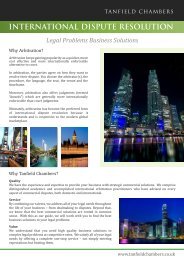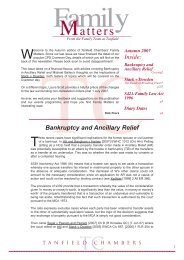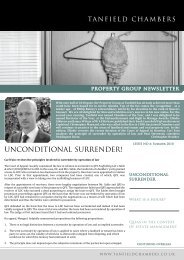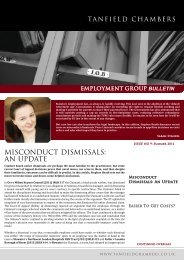Link to newsletter - Tanfield Chambers
Link to newsletter - Tanfield Chambers
Link to newsletter - Tanfield Chambers
You also want an ePaper? Increase the reach of your titles
YUMPU automatically turns print PDFs into web optimized ePapers that Google loves.
TA N F I E L D C H A M B E R S<br />
property group <strong>newsletter</strong><br />
“2010 has started brightly for the Property Group. Yet again we have been recognised in the<br />
recent editions of <strong>Chambers</strong> and Partners and the Legal 500. The second edition of our book<br />
“Service Charges and Management: Law and Practice” has been published by Sweet &<br />
Maxwell and has been well received. I am proud <strong>to</strong> have won the Real Estate Junior of the<br />
Year at the <strong>Chambers</strong> and Partners Bar Awards. I could not have done it without the able<br />
support of the Property Group as a whole. In this issue there are two articles from up and<br />
coming junior members of the team and a profile of Joanne Meah, our clerk.”<br />
Philip Rainey, Head of the <strong>Tanfield</strong> Property Group<br />
PROTECTING OVERAGE RIGHTS<br />
ISSUE NO 5: Winter 2010<br />
Andrew Sheftel discusses some potential pitfalls with overage agreements and offers practical<br />
solutions.<br />
Overage in relation <strong>to</strong> land generally refers <strong>to</strong> a sum of money which will be payable <strong>to</strong> a seller of land<br />
at a time after the sale and upon the happening of a specified event. It is commonly used in connection<br />
with land which is intended <strong>to</strong> be developed, particularly when its potential value is still uncertain.<br />
Overage can be included in a wide range of transactions from an individual selling a plot at the bot<strong>to</strong>m<br />
of their garden <strong>to</strong> a local authority selling a large site <strong>to</strong> be developed in<strong>to</strong> a new housing estate.<br />
Indeed, the former has recently become a political issue with calls <strong>to</strong> restrict ‘garden grabbing’, i.e. an<br />
owner effectively selling part of their land <strong>to</strong> a developer.<br />
Typically, overage often becomes payable upon the grant of planning permission, the construction of<br />
houses or buildings, or the onward sale of developed land. The amount payable can range from a flat<br />
sum <strong>to</strong> a percentage of the profit achieved by the seller, calculated using a mathematical formula.<br />
Whatever the parties agree upon with regard <strong>to</strong> overage, however, it is imperative that the drafting is<br />
clear and accurate both as <strong>to</strong> when the obligation <strong>to</strong> make payment will arise and how such payment<br />
will be calculated. It will also be necessary <strong>to</strong> ensure that the obligation is drafted so that the buyer<br />
cannot avoid the trigger event occurring.<br />
However, in addition <strong>to</strong> drafting considerations, a separate issue is how the seller can protect himself<br />
<strong>to</strong> secure the overage payment, beyond the mere contractual right which may prove worthless if the<br />
buyer becomes insolvent and/or attempts <strong>to</strong> sell on the land without the seller’s knowledge. Indeed,<br />
in Akasuc Enterprise Ltd & Ors v Farmar & Shirreff (a firm) [2003] EWHC 1275 (Ch), the<br />
defendant firm was negligent in failing <strong>to</strong> incorporate an appropriate mechanism <strong>to</strong> protect an<br />
overage payment.<br />
PROTECTING OVERAGE<br />
RIGHTS<br />
ACQUIRING FREEHOLDS<br />
WHEN LANDLORDS ARE<br />
MISSING<br />
continued overleaf<br />
W W W. T A N F I E L D C H A M B E R S . C O . U K
our authors<br />
It is not sufficient simply <strong>to</strong> rely on a covenant between the original<br />
parties – if the land is sold prior <strong>to</strong> the overage trigger event occurring<br />
there will be no privity of contract between the respective owners<br />
when the condition is eventually satisfied. Moreover, the burden of a<br />
positive covenant does not run with the land at law or in equity (unlike<br />
the burden of restrictive (i.e. negative) covenants which can run in<br />
equity <strong>to</strong> bind a buyer). The fact that a subsequent buyer knew of the<br />
covenant does not mean that he is bound by its provisions if it is a<br />
positive covenant. Courts will look at the substance rather than the<br />
form of a covenant in order <strong>to</strong> determine whether it is positive or<br />
negative. Generally, covenants requiring expenditure of money for<br />
their performance are positive in nature (e.g. Austerberry<br />
Corporation v Oldham (1885) 29 ChD 750). Express obligations <strong>to</strong><br />
pay overage are therefore generally regarded as positive.<br />
Accordingly, where an obligation <strong>to</strong> pay overage is contained in a<br />
positive covenant, it must be supported by some other legal device.<br />
One of the most common ways <strong>to</strong> protect a positive overage covenant<br />
is <strong>to</strong> ensure that the buyer also covenants <strong>to</strong> ensure that its successors<br />
in title will enter in<strong>to</strong> a similar commitment <strong>to</strong> the seller. A restriction<br />
is then placed against the buyer’s title preventing any dealing with the<br />
land without the consent of the seller. This method of protecting<br />
overage rights has the benefit of being simple and cost effective as a<br />
standard form restriction can be used (Form N is the one most often<br />
used for overage). The use of a restriction <strong>to</strong> secure overage obligations<br />
is in wide use. However, where the land is <strong>to</strong> be purchased by way of<br />
mortgage, the co-operation of the bank will be required.<br />
Many different techniques have been developed <strong>to</strong> protect overage and<br />
it is necessary <strong>to</strong> give consideration <strong>to</strong> the risks involved and what may<br />
or may not be appropriate depending on the nature of transaction and<br />
the parties there<strong>to</strong>. For example, another form of possible protection is<br />
the use of a ransom strip of land, which would be retained by the seller<br />
so as <strong>to</strong> prevent development until the overage is paid. However, this<br />
would not be applicable where the buyer has an alternative means of<br />
access. An alternative mechanism is for the seller <strong>to</strong> take a charge over<br />
the land <strong>to</strong> secure the future overage payment. However, this will not<br />
usually be appropriate if the land is <strong>to</strong> be purchased with the aid of a<br />
mortgage as the bank may insist upon having a sole legal mortgage<br />
over the land. A lender may allow the seller <strong>to</strong> take a second mortgage<br />
over the land but the lender will want <strong>to</strong> ensure that its mortgage takes<br />
priority.<br />
The seller could impose a restrictive covenant on the land, for example<br />
a covenant not <strong>to</strong> build or develop the land. It should be noted that<br />
attempting <strong>to</strong> rely on a simple restrictive covenant, without reference<br />
<strong>to</strong> money, could cause its own problems. Use of this device requires<br />
that the seller retain some land as there must be some land with the<br />
benefit of the restrictive covenant. Under section 84(1)(aa) of the Law<br />
of Property Act 1925 the Lands Tribunal (Upper Tribunal) has powers<br />
<strong>to</strong> vary and/or release restrictive covenants where the covenant<br />
prevents “some reasonable user” of the land for public or private<br />
purposes. Moreover, compensation payable for variation or discharge<br />
of such a covenant would be determined by reference <strong>to</strong> the “loss or<br />
disadvantage” suffered by the discharge or variation – i.e. essentially<br />
the diminution in value of the land that had benefited from the<br />
covenant, rather than the development value of the developed land.<br />
In summary, where the parties have agreed that overage provisions<br />
will form part of a sale, practitioners must ensure that the sale<br />
agreement is drafted clearly so as <strong>to</strong> address the issues of when<br />
overage will be payable (the trigger event) and how much it will be (the<br />
method of calculation). It is also vital <strong>to</strong> consider how best <strong>to</strong> secure the<br />
overage obligation and which legal device is most suitable for the<br />
particular transaction.<br />
Andrew Sheftel<br />
TC<br />
ACQUIRING FREEHOLD<br />
ARE MISSING<br />
Cecily Crampin considers the options open <strong>to</strong> long leaseholders<br />
When leases are long with little reversionary interest and ground rent is<br />
low, it is not uncommon for landlords <strong>to</strong> go missing leaving properties in<br />
an increasing state of disrepair. An obvious solution is for the lessees <strong>to</strong><br />
acquire the freehold. Advisors for lessees in situations such as these may<br />
suggest collective enfranchisement using the missing landlord procedure.<br />
This article suggests that an acquisition order should be considered as an<br />
alternative route.<br />
Acquisition orders, made by the county court under the Landlord and<br />
Tenant Act 1987 (“LTA”) are often thought of as a second stage <strong>to</strong> the<br />
court’s power <strong>to</strong> appoint a manager for premises. However, an acquisition<br />
order can be made, even when there has been no such manager, if the<br />
landlord is in breach of an obligation <strong>to</strong> the tenants that relates <strong>to</strong> the<br />
management of the premises, and that breach is likely <strong>to</strong> continue. It is<br />
this provision, s29(2) of the LTA, which assists where the landlord cannot<br />
be found, since a landlord who cannot be traced will likely be in breach of<br />
any covenants <strong>to</strong> repair, maintain, improve and insure the premises.<br />
Tracing the landlord<br />
Both applications for acquisition orders and claims for collective<br />
enfranchisement usually start when the qualifying tenants issue a notice<br />
<strong>to</strong> the landlord, the preliminary notice for acquisition orders and the<br />
initial notice for enfranchisement. For both, the relevant statute sets out<br />
what tenants should do if the landlord cannot be traced. The<br />
requirements are similar.<br />
Section 26 of the Leasehold Reform, Housing and Urban Development Act<br />
1993 (“LRHUDA”) governs missing landlords in enfranchisement. Where<br />
neither the freeholder nor any intermediate landlords can be found, the<br />
tenants should apply <strong>to</strong> the county court for a vesting order. For<br />
acquisition orders, an application under s27 of the LTA <strong>to</strong> dispense with<br />
service of the preliminary notice must be made, as well as the application<br />
for an acquisition order.<br />
In both cases, the court may require the tenants <strong>to</strong> take further steps <strong>to</strong><br />
trace the landlord. No statu<strong>to</strong>ry suggestions are made for acquisition<br />
orders, but the requirements are likely <strong>to</strong> be similar <strong>to</strong> those for<br />
enfranchisement, in which advertisement is specifically mentioned<br />
(LRHUDA s26(5)). In both cases, tenants should check the Land Register,<br />
the elec<strong>to</strong>ral roll and the register of deaths, and consider advertising in<br />
local and national papers.<br />
Qualifying tenants and qualifying premises<br />
The qualification requirements for acquisition orders are very similar <strong>to</strong><br />
those for collective enfranchisement. In both cases, qualifying tenants<br />
W W W. TA N F I E L D C H A M B E R S . C O . U K
Cecily Crampin<br />
Cecily Crampin joined <strong>Chambers</strong> in September<br />
2009 after successful completion of her<br />
pupillage, and is building her practice within<br />
the property group.<br />
She has been instructed in a negligence claim<br />
relating <strong>to</strong> an application for the right <strong>to</strong><br />
manage, and has advised in relation <strong>to</strong> enfranchisement and<br />
acquisition orders. She is a contribu<strong>to</strong>r <strong>to</strong> the second edition of<br />
<strong>Chambers</strong>’ book on Service Charges and Management: Law and<br />
Practice.<br />
Outside work Cecily enjoys singing, and recently sang the role of First<br />
Witch in a very amateur concert performance of Purcell’s Dido and<br />
Aeneas.<br />
Andrew Sheftel<br />
Since becoming a tenant in 2005, Andrew<br />
has gained wide experience in propertyrelated<br />
work. He is instructed in all areas of<br />
landlord and tenant, both residential and<br />
commercial, and appears before both the<br />
courts and the LVT.<br />
In addition, Andrew is regularly instructed <strong>to</strong> advise on issues of<br />
real property. He is also a contribu<strong>to</strong>r <strong>to</strong> the second edition of<br />
Service Charges and Management: Law and Practice.<br />
Outside work, Andrew has temporarily abandoned his other<br />
interests <strong>to</strong> spend as much time as possible with his newborn son.<br />
S WHEN LANDLORDS<br />
when their landlords go missing.<br />
must have leases longer than 21 years (LRHUDA s7(1) and LTA s59(3)),<br />
and they must hold at least two thirds of the <strong>to</strong>tal number of flats<br />
(LRHUDA s3(1) and LTA s25(2)), with two thirds of the qualifying tenants<br />
wishing <strong>to</strong> participate in the process (LRHUDA s26(1) and LTA s28(1)).<br />
Enfranchisement requires the premises <strong>to</strong> be self-contained (LRHUDA s3)<br />
whereas an acquisition order may be obtained in relation <strong>to</strong> “the whole or<br />
part of a building” (LTA s25(2)). An acquisition order cannot be made<br />
where more than 50% of the internal floor area of the premises is<br />
occupied for non-residential purposes (LTA s25(4)). There is a similar<br />
requirement for enfranchisement, but the non-residential percentage<br />
floor area is 25% (LRHUDA s4(1)). Thus the acquisition order route might<br />
allow tenants <strong>to</strong> acquire their freehold when enfranchisement is<br />
excluded.<br />
Advantages of acquisition orders<br />
The missing landlord procedure for collective enfranchisement gives<br />
tenants a method of bypassing the initial notice when the landlord cannot<br />
be found. If the application is successful, the county court makes a vesting<br />
order, meaning in this case that the court will appoint a district judge <strong>to</strong><br />
convey the premises <strong>to</strong> a purchaser nominated by the tenants on the<br />
payment in<strong>to</strong> court of the price (LRHUDA s27(3)). The terms of the<br />
conveyance and the price are determined by a Leasehold Valuation<br />
Tribunal, however (s27). The price for the landlord’s interest is<br />
determined on the usual basis for enfranchisement (s27(5)), and hence<br />
will include marriage value. The tenants will have <strong>to</strong> pay any recoverable<br />
outstanding rent or service charges <strong>to</strong>o.<br />
An application for an acquisition order where the landlord is missing<br />
involves a completely different procedure. The court makes a vesting<br />
order under s33 of LTA. This time, however, the terms of acquisition and<br />
the conveyance are determined by the court and there is no need for a<br />
conveyance. Under s33(3), the freehold vests in the nominated person on<br />
payment in<strong>to</strong> court of the price determined.<br />
Furthermore, for an acquisition order there is no need for a reference <strong>to</strong><br />
the LVT. The price <strong>to</strong> be paid for the landlord’s interest is certified by a<br />
surveyor appointed by the President of the Lands Tribunal (s33(2) of the<br />
LTA), and is calculated on the assumption that none of the tenants of the<br />
premises are seeking <strong>to</strong> buy. The price should not include marriage value,<br />
which gives the acquisition order route an immediate advantage for<br />
tenants with 80 years or less unexpired term. Note that the price will<br />
include recoverable rent as above.<br />
The acquisition order route is likely <strong>to</strong> be cheaper in relation <strong>to</strong> costs <strong>to</strong>o<br />
since it requires determination of the price by a surveyor without a<br />
hearing, rather than representation before an LVT. Perhaps more<br />
significantly, if an acquisition order is granted, an application <strong>to</strong> the court<br />
for the tenant’s costs may be successful. Since acquisition orders are<br />
designed <strong>to</strong> remedy wrongs <strong>to</strong> tenants by their landlord, a court might<br />
award costs against the landlord <strong>to</strong> be set off against the money <strong>to</strong> be paid<br />
in<strong>to</strong> court. Such costs were awarded in Gray v Standard Home &<br />
Counties Properties Ltd [1994] 1 EGLR 119 (although that was not a<br />
missing landlord case).<br />
If the landlord is missing in an enfranchisement case, a court might<br />
similarly award the costs of the application for a vesting order against the<br />
landlord because of the landlord’s failure <strong>to</strong> maintain a good address for<br />
service of notices on him under s48 of the LTA. The costs in the LVT,<br />
however, would not be recoverable; the costs of the surveyor in the Lands<br />
Tribunal for an acquisition order might well be.<br />
Conclusion<br />
Collective enfranchisement has one obvious advantage over acquisition<br />
orders. Once the court is satisfied that the tenants qualify for<br />
enfranchisement and that the landlord is missing, it has no discretion; the<br />
tenants have the right <strong>to</strong> acquire the freehold. The procedure for<br />
obtaining an acquisition order is discretionary, however. Even if the<br />
tenants and premises qualify, and the landlord has been in breach of<br />
management obligations, the court could decide not <strong>to</strong> make an<br />
acquisition order at all, preferring instead, for example, <strong>to</strong> order the<br />
appointment of a manager. It seems likely, however, that the long term<br />
absence of a landlord, for example a long standing failure <strong>to</strong> insure the<br />
property, should be sufficient. If a landlord has all but abandoned the<br />
property, there seems little reason why the tenants’ acquisition of the<br />
freehold is not the appropriate solution.<br />
Cecily Crampin<br />
W W W. TA N F I E L D C H A M B E R S . C O . U K
Joanne meah<br />
<strong>Tanfield</strong> <strong>Chambers</strong> welcomed Joanne in<br />
2008 as <strong>Chambers</strong> Property Clerk. She<br />
started clerking in 2004 and passed the<br />
Institute of Barristers Clerks (IBC) BTEC<br />
course in 2006. She is also a member of the<br />
IBC.<br />
Joanne’s approachable style and “can do” attitude along with a<br />
flexible yet thorough manner when dealing with fees is appreciated<br />
by clients who often sing her praises.<br />
In her spare time Joanne is a keen runner and enjoys socialising<br />
with family and friends.<br />
property barristers:<br />
Geraint Jones QC (1976)<br />
David Berkley QC (1979)<br />
Paul Staddon (1976)<br />
Mark Dencer (1978)<br />
David Daly (1979)<br />
Chris<strong>to</strong>pher Coney (1979)<br />
Charles Joseph (1980)<br />
Mark Loveday (1986)<br />
Michael Buckpitt (1988)<br />
Philip Rainey (1990)<br />
Phillip Aliker (1990)<br />
Nicholas Isaac (1993)<br />
Andrew Butler (1993)<br />
Stan Gallagher (1994)<br />
Chris<strong>to</strong>pher Heather (1995)<br />
Timothy Polli (1997)<br />
James Fieldsend (1997)<br />
Alejandra Hormaeche (1998)<br />
Marc Glover (1999)<br />
Ellodie Gibbons (1999)<br />
Adrian Carr (1999)<br />
Carl Fain (2001)<br />
Tom Carpenter-Leitch (2002)<br />
Tim Hammond (2003)<br />
Amanda Gourlay (2004)<br />
Andrew Sheftel (2004)<br />
Louise Mankau (2005)<br />
Paul Stevenson (2006)<br />
Gemma de Cordova (2006)<br />
Cecily Crampin (2008)<br />
For further information or <strong>to</strong> instruct a barrister, please contact<br />
Joanne Price, Property Clerk or Kevin Moore, Senior Clerk, on<br />
T: +44 (0) 20 7421 5300 or E: clerks@tanfieldchambers.co.uk<br />
<strong>Tanfield</strong> <strong>Chambers</strong>’ dedicated conference facilities are readily accessible<br />
by the mobility-impaired. Please contact the clerks <strong>to</strong> agree fees in<br />
advance, whether on a fixed or hourly rate. Feedback on our service is<br />
welcomed and should be directed <strong>to</strong> the Senior Clerk, Kevin Moore. A<br />
copy of <strong>Chambers</strong> Complaints’ Procedure is available on our website or<br />
on request.<br />
To contact us: T: +44 (0) 20 7421 5300, F: +44 (0) 20 7421 5333, DX: 46 London Chancery Lane, E: clerks@tanfieldchambers.co.uk<br />
Address: <strong>Tanfield</strong> <strong>Chambers</strong>, 2-5 Warwick Court, London, WC1R 5DJ


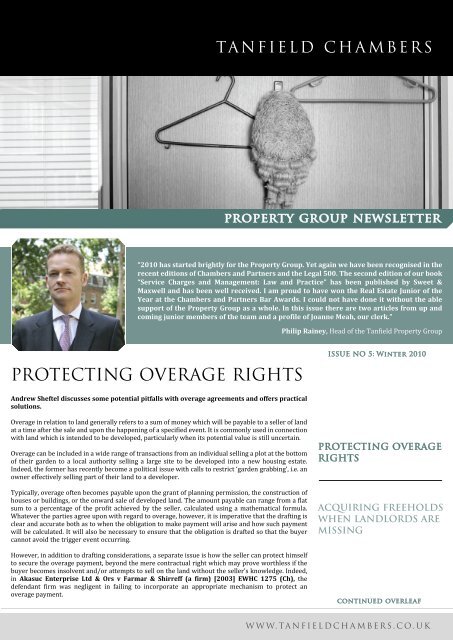
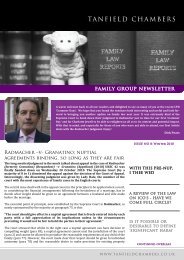


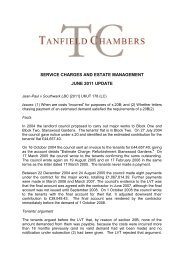
![Re Clarise Properties Ltd [2012] UKUT 4 (LC) - Tanfield Chambers](https://img.yumpu.com/36301708/1/190x245/re-clarise-properties-ltd-2012-ukut-4-lc-tanfield-chambers.jpg?quality=85)


